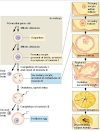Cerebral Cortex and its division
Cerebral cortex is divided into to main divisions.
Motor cortex:
Motor cortex area is concerned with motor control.
Somatosensory cortex :
Somatosensory cortex is concerned with sensory control.
Let's go into the detail of motor cortex.
The motor cortex is subdivided into the following areas.
Primary motor cortex.
Premotor area.
Supplementary area.
Primary motor cortex:
Primary motor cortex is present anterior to the central sulcus. It starts laterally at the sylavin fissure and spread superiorly to the uppermost portion of the brain. The primary motor cortex has many areas which are concerned with various muscles of the body.
Topographical organization of primary motor cortex.
Face and mouth:
The area in the primary motor cortex which controls face and mouth muscles lies near the sylvian fissure.
Arms and hands:
Arm and Hand control area lies in the mid portion of the primary cortex.
Trunk:
The area for trunk lies towards the apex of the brain.
Legs and foot:
Area for leg and foot lies in the longitudinal fissure of the brain.
The function of the primary motor cortex:
More than 50% of the whole primary motor cortex is related to controlling hand and speech muscles. It produces discrete patterns of signals.
Premotor area:
Premotor area is present anterior to the primary motor cortex. It starts inferiorly in the sylavin fissure and superiorly it continue as a supplementary area.
Its topographical organization is approximately the same as the primary motor cortex.
Supplementary area:
The supplementary area is generally present in the longitudinal fissure but also extends a little into the superior frontal cortex.
Stimulation of this area cause bilateral movement of hand i.e grasping movement of both hands. It doesn't produce unilateral contraction.
Motor control areas in the human motor cortex:
Broca’s Area:
Broca’s area is also called the motor speech area. It is present anterior to the premotor cortex just above the sylvian fissure. This area controls proper words formation. When an injury occurs in this area a person becomes unable to speak proper words.
Eye movement area:
Above the Broca's area is another area for controlling eye movement. When any damage occurs to this area a person becomes unable to control voluntarily the eye movement towards an object. This area also controls eyelid movement i.e blinking.
Head rotation area:
Head rotation area is present above the eye movement area and controls the voluntary rotation of the head.
Area of hand skills:
This area control hand and finger movement. When the function of this area has altered a condition called Motor Apraxia is develop.
Motor Apraxia:
When damage occurs to the Hand skill control area the special coordinated movement of the hand and fingers loss and becomes nonpurposeful, this condition is called Motor Apraxia.






0 Comments